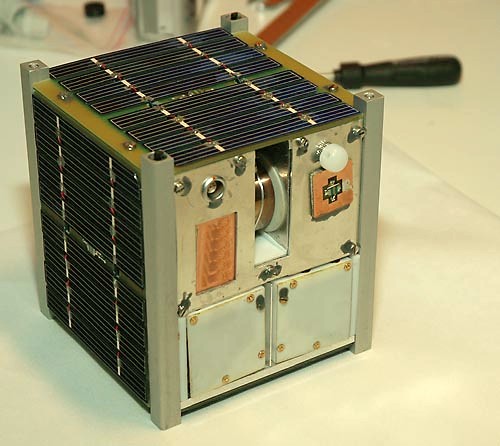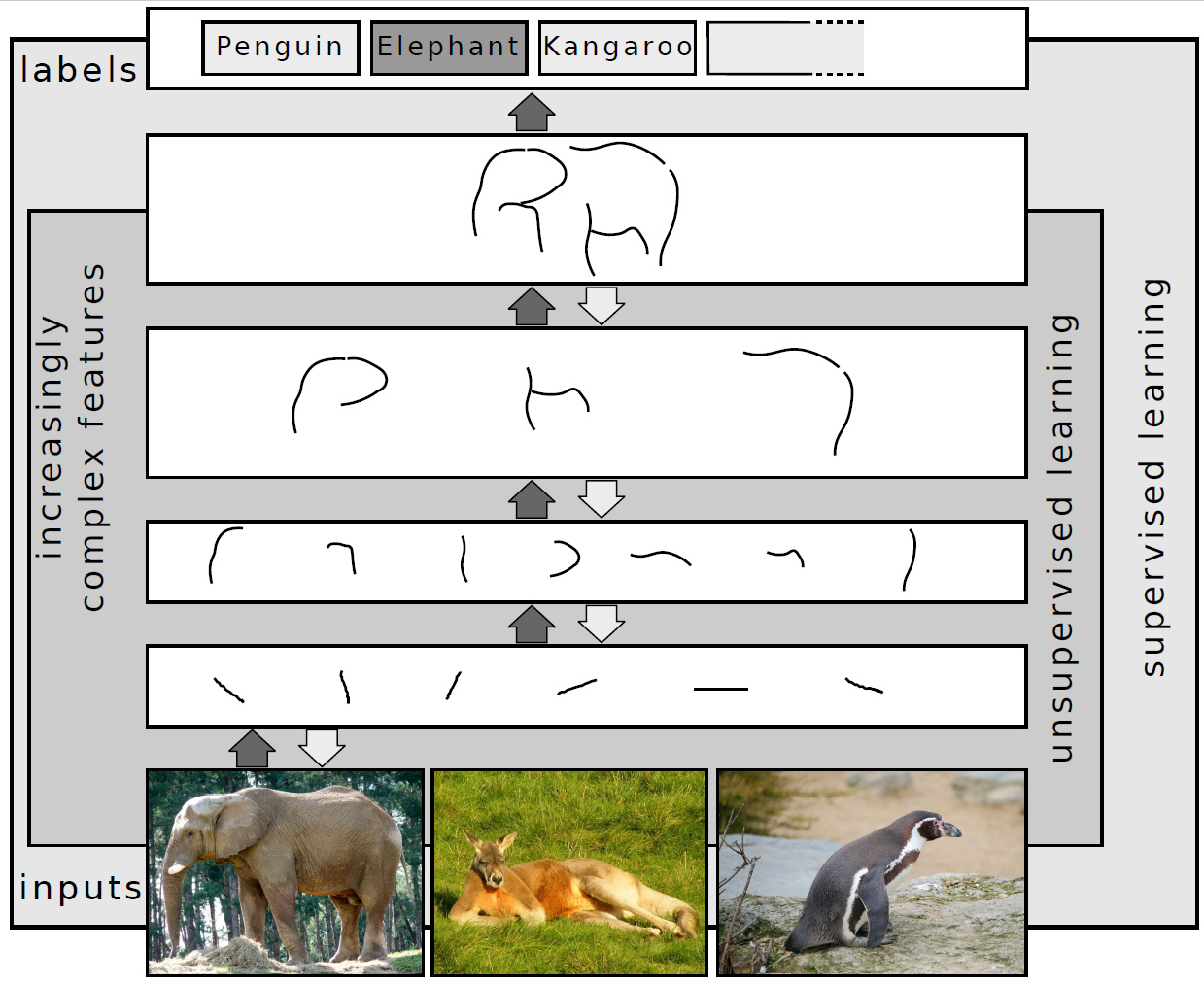|
Eyes Of Things
Eyes of Things (EoT) is the name of a project funded by the European Union’s Horizon 2020 Research and Innovation Programme under grant agreement number 643924. The purpose of the project, which is funded under the Smart Cyber-physical systems topic, is to develop a generic hardware-software platform for embedded, efficient (i.e. battery-operated, wearable, mobile), computer vision, including deep learning inference. On November 29, 2018, the European Space Agency announced that it was testing the suitability of the device for space applications in advance of a flight in a Cubesat. Motivation EoT is based on the following tenets:A Vision for the Future. D. Moloney, O. Deniz. IEEE Consumer Electronics 4(2), April 2015/ref> * Future embedded systems will have more intelligence and cognitive functionality. Vision is paramount to such intelligent capacity * Unlike other sensors, vision requires intensive processing. Power consumption must be optimized if vision is to be used in ... [...More Info...] [...Related Items...] OR: [Wikipedia] [Google] [Baidu] |
European Commission
The European Commission (EC) is the executive of the European Union (EU). It operates as a cabinet government, with 27 members of the Commission (informally known as "Commissioners") headed by a President. It includes an administrative body of about 32,000 European civil servants. The Commission is divided into departments known as Directorates-General (DGs) that can be likened to departments or ministries each headed by a Director-General who is responsible to a Commissioner. There is one member per member state, but members are bound by their oath of office to represent the general interest of the EU as a whole rather than their home state. The Commission President (currently Ursula von der Leyen) is proposed by the European Council (the 27 heads of state/governments) and elected by the European Parliament. The Council of the European Union then nominates the other members of the Commission in agreement with the nominated President, and the 27 members as a team are ... [...More Info...] [...Related Items...] OR: [Wikipedia] [Google] [Baidu] |
CubeSat
A CubeSat is a class of miniaturized satellite based around a form factor consisting of cubes. CubeSats have a mass of no more than per unit, and often use commercial off-the-shelf (COTS) components for their electronics and structure. CubeSats are put into orbit by deployers on the International Space Station, or launched as secondary payloads on a launch vehicle. , more than 1,600 CubeSats have been launched. In 1999, California Polytechnic State University (Cal Poly) professor Jordi Puig-Suari and Bob Twiggs, a professor at Stanford University Space Systems Development Laboratory, developed the CubeSat specifications to promote and develop the skills necessary for the design, manufacture, and testing of small satellites intended for low Earth orbit (LEO) that perform a number of scientific research functions and explore new space technologies. Academia accounted for the majority of CubeSat launches until 2013, when more than half of launches were for non-academic purpose ... [...More Info...] [...Related Items...] OR: [Wikipedia] [Google] [Baidu] |
Embedded Systems
An embedded system is a computer system—a combination of a computer processor, computer memory, and input/output peripheral devices—that has a dedicated function within a larger mechanical or electronic system. It is ''embedded'' as part of a complete device often including electrical or electronic hardware and mechanical parts. Because an embedded system typically controls physical operations of the machine that it is embedded within, it often has real-time computing constraints. Embedded systems control many devices in common use today. , it was estimated that ninety-eight percent of all microprocessors manufactured were used in embedded systems. Modern embedded systems are often based on microcontrollers (i.e. microprocessors with integrated memory and peripheral interfaces), but ordinary microprocessors (using external chips for memory and peripheral interface circuits) are also common, especially in more complex systems. In either case, the processor(s) use ... [...More Info...] [...Related Items...] OR: [Wikipedia] [Google] [Baidu] |
Internet Of Things
The Internet of things (IoT) describes physical objects (or groups of such objects) with sensors, processing ability, software and other technologies that connect and exchange data with other devices and systems over the Internet or other communications networks. Internet of things has been considered a misnomer because devices do not need to be connected to the public internet, they only need to be connected to a network and be individually addressable. The field has evolved due to the convergence of multiple technologies, including ubiquitous computing, commodity sensors, increasingly powerful embedded systems, as well as machine learning.Hu, J.; Niu, H.; Carrasco, J.; Lennox, B.; Arvin, F.,Fault-tolerant cooperative navigation of networked UAV swarms for forest fire monitoring Aerospace Science and Technology, 2022. Traditional fields of embedded systems, wireless sensor networks, control systems, automation (including home and building automation), independently ... [...More Info...] [...Related Items...] OR: [Wikipedia] [Google] [Baidu] |
Computer Vision
Computer vision is an Interdisciplinarity, interdisciplinary scientific field that deals with how computers can gain high-level understanding from digital images or videos. From the perspective of engineering, it seeks to understand and automate tasks that the human visual system can do. Computer vision tasks include methods for image sensor, acquiring, Image processing, processing, Image analysis, analyzing and understanding digital images, and extraction of high-dimensional data from the real world in order to produce numerical or symbolic information, e.g. in the forms of decisions. Understanding in this context means the transformation of visual images (the input of the retina) into descriptions of the world that make sense to thought processes and can elicit appropriate action. This image understanding can be seen as the disentangling of symbolic information from image data using models constructed with the aid of geometry, physics, statistics, and learning theory. The scien ... [...More Info...] [...Related Items...] OR: [Wikipedia] [Google] [Baidu] |
Wearable Camera
A body camera, bodycam, body worn video (BWV), body-worn camera, or wearable camera is a wearable audio, video, or photographic recording system. Body cameras have a range of uses and designs, of which the best-known use is as a part of policing equipment. Other uses include action cameras for social and recreational (including cycling), within the world of commerce, in healthcare and medical use, in military use, journalism, citizen sousveillance and covert surveillance. Research on the impact of body-worn cameras in law enforcement shows mixed evidence as to the impact of cameras on the use of force by law enforcement and communities' trust in police. Designs Body-worn cameras are often designed to be worn in one of three locations: on the torso, on or built into a helmet, and on or built into glasses. Some feature live streaming capabilities, such as GPS positioning, automatic offload to cloud storage, while others are based on local storage. Some body-worn cameras off ... [...More Info...] [...Related Items...] OR: [Wikipedia] [Google] [Baidu] |
Movidius
Movidius is a company based in San Mateo, California, that designs specialised low-power processor chips for computer vision. The company was acquired by Intel in September 2016. Company history Movidius was co-founded in Dublin in 2005, by Sean Mitchell and David Moloney. Between 2006 and 2016, it raised nearly $90 million in capital funding. In May 2013, the company appointed Remi El-Ouazzane as CEO. In January 2016, the company announced a partnership with Google. Movidius has been active in Google's Project Tango project, and Movidius also announced a planned acquisition by Intel in September 2016. Products Myriad 2 The company's Myriad 2 chip is an always-on manycore vision processing unit that can function on power-constrained devices. The ''Fathom'' is a USB stick containing a Myriad 2 processor, allowing a vision accelerator to be added to devices using ARM processors including PCs, drones, robots, IoT devices and video surveillance for tasks such as identifying peo ... [...More Info...] [...Related Items...] OR: [Wikipedia] [Google] [Baidu] |
Eyes Of Things
Eyes of Things (EoT) is the name of a project funded by the European Union’s Horizon 2020 Research and Innovation Programme under grant agreement number 643924. The purpose of the project, which is funded under the Smart Cyber-physical systems topic, is to develop a generic hardware-software platform for embedded, efficient (i.e. battery-operated, wearable, mobile), computer vision, including deep learning inference. On November 29, 2018, the European Space Agency announced that it was testing the suitability of the device for space applications in advance of a flight in a Cubesat. Motivation EoT is based on the following tenets:A Vision for the Future. D. Moloney, O. Deniz. IEEE Consumer Electronics 4(2), April 2015/ref> * Future embedded systems will have more intelligence and cognitive functionality. Vision is paramount to such intelligent capacity * Unlike other sensors, vision requires intensive processing. Power consumption must be optimized if vision is to be used in ... [...More Info...] [...Related Items...] OR: [Wikipedia] [Google] [Baidu] |
European Space Agency
, owners = , headquarters = Paris, Île-de-France, France , coordinates = , spaceport = Guiana Space Centre , seal = File:ESA emblem seal.png , seal_size = 130px , image = Views in the Main Control Room (12052189474).jpg , size = , caption = , acronym = , established = , employees = 2,200 , administrator = Director General Josef Aschbacher , budget = €7.2 billion (2022) , language = English and French (working languages) , website = , logo = European Space Agency logo.svg , logo_caption = Logo , image_caption = European Space Operations Centre (ESOC) Main Control Room The European Space Agency (ESA; french: Agence spatiale européenne , it, Agenzia Spaziale Europea, es, Agencia Espacial Europea ASE; german: Europäische Weltraumorganisation) is an intergovernmental organisation of 22 member states dedicated to the exploration of space. Established in 1975 and headquartered ... [...More Info...] [...Related Items...] OR: [Wikipedia] [Google] [Baidu] |
Framework Programmes For Research And Technological Development
The Framework Programmes for Research and Technological Development, also called Framework Programmes or abbreviated FP1 to FP9, are funding programmes created by the European Union/European Commission to support and foster research in the European Research Area (ERA). Starting in 2014, the funding programmes were named Horizon. The funding programmes began in 1984 and continue to the present day. The most recent programme, Horizon Europe, has a budget of 95.5 billion Euros to be distributed over 7 years. The specific objectives and actions vary between funding periods. In FP6 and FP7, focus was on technological research. In Horizon 2020, the focus was on innovation, delivering economic growth faster, and delivering solutions to end users that are often governmental agencies. Background Conducting European research policies and implementing European research programmes is an obligation under the Amsterdam Treaty, which includes a chapter on research and technological developme ... [...More Info...] [...Related Items...] OR: [Wikipedia] [Google] [Baidu] |
Deep Learning
Deep learning (also known as deep structured learning) is part of a broader family of machine learning methods based on artificial neural networks with representation learning. Learning can be Supervised learning, supervised, Semi-supervised learning, semi-supervised or Unsupervised learning, unsupervised. Deep-learning architectures such as #Deep_neural_networks, deep neural networks, deep belief networks, deep reinforcement learning, recurrent neural networks, convolutional neural networks and Transformer (machine learning model), Transformers have been applied to fields including computer vision, speech recognition, natural language processing, machine translation, bioinformatics, drug design, medical image analysis, Climatology, climate science, material inspection and board game programs, where they have produced results comparable to and in some cases surpassing human expert performance. Artificial neural networks (ANNs) were inspired by information processing and distr ... [...More Info...] [...Related Items...] OR: [Wikipedia] [Google] [Baidu] |
Computer Vision
Computer vision is an Interdisciplinarity, interdisciplinary scientific field that deals with how computers can gain high-level understanding from digital images or videos. From the perspective of engineering, it seeks to understand and automate tasks that the human visual system can do. Computer vision tasks include methods for image sensor, acquiring, Image processing, processing, Image analysis, analyzing and understanding digital images, and extraction of high-dimensional data from the real world in order to produce numerical or symbolic information, e.g. in the forms of decisions. Understanding in this context means the transformation of visual images (the input of the retina) into descriptions of the world that make sense to thought processes and can elicit appropriate action. This image understanding can be seen as the disentangling of symbolic information from image data using models constructed with the aid of geometry, physics, statistics, and learning theory. The scien ... [...More Info...] [...Related Items...] OR: [Wikipedia] [Google] [Baidu] |




.jpg)
_(cropped).png)


